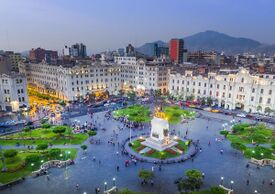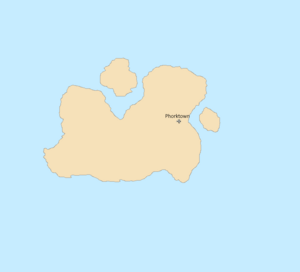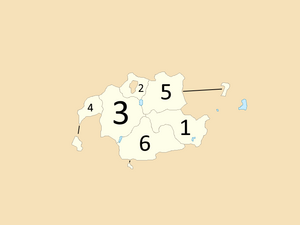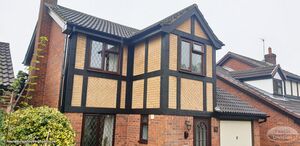Phorktown: Difference between revisions
mNo edit summary |
No edit summary |
||
| Line 103: | Line 103: | ||
}} | }} | ||
'''Phorktown City''' (<small>/fɔːktaʊn/ ([[File:Speaker Icon.svg|13px]] [ | '''Phorktown City''' (<small>/fɔːktaʊn/ ([[File:Speaker Icon.svg|13px]] [http://ipa-reader.xyz/?text=f%C9%94%CB%90kta%CA%8An&voice=Brian listen])</small>), often called simply '''Phorktown''', is the second populous city in [[Philimania]]. With an estimated 2019 population of 1,765,200 distributed over about 1,222 km2 (472 sq mi). The city is located at the Northeastern tip of the province of [[New Cardiff]]. | ||
Phorktown is composed of six districts. The six districts—[[Wellam District|Wellam]], [[Brake District|Brake]], [[East Phorktown District|East Phorktown]], [[Admira District|Admira]], [[Flinthead District|Flinthead]], and [[Beadrun District|Beadrun]]—were created in 1680, after city status was granted to the city. As many as 600 languages are spoken in Phorktown, making it one of the most linguistically diverse city in the world. Phorktown is home to roughly 1 million residents born outside [[Philimania]]. As of 2019, Phorktown is estimated to produce a [[Gross domestic product|GDP]] of P$342,635 billion. | Phorktown is composed of six districts. The six districts—[[Wellam District|Wellam]], [[Brake District|Brake]], [[East Phorktown District|East Phorktown]], [[Admira District|Admira]], [[Flinthead District|Flinthead]], and [[Beadrun District|Beadrun]]—were created in 1680, after city status was granted to the city. As many as 600 languages are spoken in Phorktown, making it one of the most linguistically diverse city in the world. Phorktown is home to roughly 1 million residents born outside [[Philimania]]. As of 2019, Phorktown is estimated to produce a [[Gross domestic product|GDP]] of P$342,635 billion. | ||
Revision as of 02:29, 6 September 2021
Phorktown | |
|---|---|
City | |
| Other transcription(s) | |
| • Chinese | 福克敦 |
| • Spanish | Phorktown |
 The Central Square in Flinthead District | |
| Nickname: PT | |
| Motto(s): Born in freedom, live in freedom, die in freedom | |
| Country | Philimania |
| Province | New Cardiff |
| Districts | List |
| Establishment | 23 May 1632 |
| City status | 5 March 1680 |
| Government | |
| • Type | Mayor–Council |
| • Body | Phorktown City Council |
| • Mayor | William Grey |
| Area | |
| • Total | 1,222 km2 (472 sq mi) |
| • Metro | 553 km2 (214 sq mi) |
| Elevation | 5 m (16 ft) |
| Population (2019) | |
| • Total | 1,765,200 |
| • Density | 1,444/km2 (3,740/sq mi) |
| • Urban | 785,324 |
| • Metro | 979,876 |
| • Metro density | 1,772/km2 (4,590/sq mi) |
| • Demonym | Phorker |
| City Index | |
| • HDI (2019) | |
| • GDP (2020) | |
| • Per capita (2020) | |
| Time zone | UTC-8 (GMT-6) |
| Postal code | 800 to 40000 |
| Area code(s) | 45, 46 |
| Vehicle registration | T (except taxis) NC (for taxis only) |
| Rapid Transit | |
| Official language(s) | English Spanish (de facto) |
| Website | www.pt.gov |
Phorktown City (/fɔːktaʊn/ ( listen)), often called simply Phorktown, is the second populous city in Philimania. With an estimated 2019 population of 1,765,200 distributed over about 1,222 km2 (472 sq mi). The city is located at the Northeastern tip of the province of New Cardiff.
Phorktown is composed of six districts. The six districts—Wellam, Brake, East Phorktown, Admira, Flinthead, and Beadrun—were created in 1680, after city status was granted to the city. As many as 600 languages are spoken in Phorktown, making it one of the most linguistically diverse city in the world. Phorktown is home to roughly 1 million residents born outside Philimania. As of 2019, Phorktown is estimated to produce a GDP of P$342,635 billion.
Phorktown traces its origins to a trading post founded by a buisnessman named Jacob Phork in 1632. Phorktown saw one of the longest battle in human history known as the Battle of Phorktown Hill which led to the surrender of Philimania to Long Kingdom and Spain. In the 21st century, Phorktown has emerged as a global node of cultural diversity.
Etymology
THe city was named after the founder of the city—Jacob Phork.
History
Early History
A permanent Philimanian presence in what is now Phorktown began in 1632 with the founding of the wood industry in the area. In 1636, construction was started on a citadel called Fort Phork, in present-day Beadrun District.
Following the construction of Fort Phork, Phorktown grew slowly. Settlers form the coast were encouraged to move to Phorktown to find work, and the area began to thrive.
Since 1640, the Phork Trade Company had operated as a monopoly in Philimania, on authority granted by the Governer of Philimania. In 1643–1657, in an effort to bolster economic growth, the Phork Trade Company relinquished its monopoly over the wood industry, leading to growth in the production and trade of food, timber, and tobacco.
In 1666, the Phorktown City Council was formed. Shortly after the council's formation, the population of Phorktown grew from 1,500 to 9,000. Charles Peters, the first mayor, has been credited with improving law and order in Phorktown; however, he also earned a reputation as a despotic leader. He instituted regulations on liquor sales, attempted to assert control over the Church, and blocked other religious groups from establishing houses of worship. The Phork Trade Company would eventually attempt to ease tensions between Peters and residents of Phorktown.
In 1680, the city was named the capital of Philimania and it became a major South American economic hub.
The Long Kingdomian Revolution
Following The Seven Years War, in 1768, Philimania's economy deteriorated. So on July 23rd in that year, the president at that time, Kareen Rallington passed an act known as the Comertua Act, it states that taxes in Largoia, modern day Long Kingdom would be raised by 20% and that Philimanian goods bought or sold would cost twice as much. The Largoian were not happy.
In 1768, a Largoian revolutionist and around 500 other Largoians took to the streets of Browningham, the capital of Largoia. After a series of protests, the Philimanian soldiers were sent in to deal with the protesters. as soon as the army entered the city, rocks were thrown at them. The soldiers, overwhelmed by the number of protesters, they fired into the crowd. many protesters were killed and this event would be known as the Browningham Massacre. The news of this event spreaded like wildfire. The Largoian were outraged, so they armed themselves with weapons and revolted against Philimania.
The Long Kingdomian Revolution started on August 10th 1768. The general of the Philimanian army, launched an all-out assault on the beaches of Largoia with insignificant losses. By October, the Long Kingdomian Revolution seemed to be coming to a close for all Long Kingdomian units have either been surrounded or captured; But, a month ago, a Long Kingdomian ambassador was sent to Spain to ask them for help, the Spanish agreed. So on the 5th of November in that year, Philimanian forces were driven off the island, but not after a final stand at the Battle of Pices Beach. It was estimated that Spain and The Long Kingdom suffered twice as much as Philimania.
By February 1769, Spanish and Long Kingdomian forces were pushing Philimanian forces into their own island. Eventually, they reached Phorktown, where the Philimanians made a last-ditch attempt to drive out their enemy at the Battle of Phorktown hill in Brake. Both sides suffered heavy losses, the battle lasted for a total of 13 months and ended in the destruction of most of Phorktown and Philimania's surrender on March 15th 1770 ending the Long Kingdomian Revolution.
Nineteenth Century

Over the course of the nineteenth century, Phorktown's population grew from 40,000 to 1.1 million.
The Great Irish Famine brought a large influx of Irish immigrants; more than 100,000 were living in Phorktown by 1860. There was also extensive immigration from the German provinces, where revolutions had disrupted societies, and Germans comprised another 15% of Phorktown's population by 1880.
In 1899, the capital was moved from Phorktown to New Phork by President Mahad Sanders.
Modern Era
The opening of the Phorktown Subway in 1911, first built as separate private systems, helped bind the new city together. Throughout the first half of the 20th century, the city became a South American center for industry, commerce, and communication.
From 1940-1980, thousands of immigrants came to Philimania to find work, many of them came to Phorktown, which is why the city has emerged into the 21st century as a city of cultural diversity
Geography
Phorktown is situated at the north of New Cardiff, a few miles south of New Phork. The city's total area is 1,222 km2 (472 sq mi), with an average elevation of 5 m (16 ft).
Climate and weather
Phorktown experiences a humid tropical climate with generally cool temperatures and plentiful rainfall all year round. Temperatures tend to remain constant. Maximums hover between 24 and 31 °C (75.2 and 87.8 °F) and sometimes hit 38 °C (100.4 °F), while minimums hover between 18.4 °C (65.12 °F) and have never fallen below 17.8 °C (64.0 °F).
| Climate data for Phorktown | |||||||||||||
|---|---|---|---|---|---|---|---|---|---|---|---|---|---|
| Month | Jan | Feb | Mar | Apr | May | Jun | Jul | Aug | Sep | Oct | Nov | Dec | Year |
| Record high °C (°F) | 23.0 (73.4) |
22.8 (73.0) |
22.0 (71.6) |
23.8 (74.8) |
22.2 (72.0) |
21.9 (71.4) |
25.0 (77.0) |
23.2 (73.8) |
23.4 (74.1) |
22.0 (71.6) |
22.7 (72.9) |
23.0 (73.4) |
25.0 (77.0) |
| Average high °C (°F) | 21.0 (69.8) |
23.8 (74.8) |
25.1 (77.2) |
24.1 (75.4) |
23.0 (73.4) |
22.8 (73.0) |
24.8 (76.6) |
22.3 (72.1) |
22.1 (71.8) |
25.0 (77.0) |
24.7 (76.5) |
23.5 (74.3) |
23.5 (74.3) |
| Daily mean °C (°F) | 23.7 (74.7) |
22.2 (72.0) |
24.6 (76.3) |
21.7 (71.1) |
22.8 (73.0) |
26.6 (79.9) |
24.1 (75.4) |
22.1 (71.8) |
23.0 (73.4) |
24.0 (75.2) |
22.8 (73.0) |
21.6 (70.9) |
23.3 (73.9) |
| Average low °C (°F) | 19.4 (66.9) |
20.6 (69.1) |
19.0 (66.2) |
21.3 (70.3) |
19.6 (67.3) |
21.3 (70.3) |
20.8 (69.4) |
18.9 (66.0) |
20.8 (69.4) |
21.0 (69.8) |
20.8 (69.4) |
19.6 (67.3) |
20.3 (68.4) |
| Record low °C (°F) | 17.8 (64.0) |
18.0 (64.4) |
18.9 (66.0) |
20.6 (69.1) |
20.5 (68.9) |
19.1 (66.4) |
20.1 (68.2) |
20.0 (68.0) |
21.0 (69.8) |
20.0 (68.0) |
20.7 (69.3) |
19.0 (66.2) |
17.8 (64.0) |
| Average precipitation mm (inches) | 193 (7.6) |
198 (7.8) |
257 (10.1) |
230 (9.1) |
197 (7.8) |
131 (5.2) |
148 (5.8) |
162 (6.4) |
214 (8.4) |
265 (10.4) |
321 (12.6) |
252 (9.9) |
2,568 (101.1) |
| Average rainy days | 15 | 17 | 20 | 21 | 20 | 24 | 20 | 21 | 19 | 18 | 18 | 17 | 230 |
| Average relative humidity (%) | 80 | 80 | 80 | 82 | 81 | 80 | 79 | 79 | 81 | 82 | 84 | 83 | 81 |
| Mean monthly sunshine hours | 185.0 | 192.4 | 207.9 | 198.8 | 206.8 | 194.4 | 200.2 | 189.0 | 163.8 | 169.1 | 152.3 | 162.6 | 2,222.3 |
| Climate data for Phorktown | |||||||||||||
|---|---|---|---|---|---|---|---|---|---|---|---|---|---|
| Month | Jan | Feb | Mar | Apr | May | Jun | Jul | Aug | Sep | Oct | Nov | Dec | Year |
| Mean daily daylight hours | 12.0 | 12.0 | 12.1 | 12.2 | 12.3 | 12.3 | 12.3 | 12.2 | 12.1 | 12.0 | 12.0 | 11.9 | 12.1 |
| Average Ultraviolet index | 12 | 12 | 12 | 12 | 12 | 12 | 12 | 12 | 12 | 12 | 12 | 12 | 12 |
Governance
Phorktown was administered by the Phork Trade Company from the city's founding on 23 May 1632, until 8 February 1666, after which executive power transferred to the Phorktown City Council. Seventeen mayors have been appointed since then. The current mayor is William Grey of the Green Party, who has been in office since 17 May 2017.
Local government
The local administration is carried out by the Phorktown City Council. It is responsible for public health and sanitation, waste removal and management, town planning, environmental protection and building control, social and economic development, and general maintenance functions of urban infrastructure. Executive power lies with the mayor in the city hall, who is elected for 20 years by the public. This system of electing the mayor has been in place ever since the founding of the City Council.
Districts
Phorktown's six districts, with estimated population and percentage of the total, are congruent with administrative subdivisions under the authority of the Phorktown City Council.
Demographics
Population density
Phorktown is the second most populous city in Philimania, with a population of 1.7652 million in the city proper as of 2019. It has a population density of 1,444 inhabitants per square kilometre (3,740/sq mi), and is the most densely populated administrative district in Philimania.
Race and ethnicity
Phorktown's populace includes many ethnic groups such as Philimanian, Haspanic, Afro-Ecuadorian, German, Han Chinese, Ibans Irish, Jews, Italians, and other indigenous races from around South America.
Approximately 60% of the city's population is foreign born, and more than half of all children are born to mothers who are immigrants as of 2020. In Phorktown, no single country or region of origin dominates. The ten largest sources of foreign-born individuals in the city as of 2021 were Peru, China, Mexico, Namibia, Poland, Ecuador, Ireland, India, Russia, and Trinidad and Tobago.
Economy
Phorktown City is a South American hub of business and commerce, as a center for retailing, world trade, transportation, tourism, advertising, legal services, accountancy, theater, and fashion, in Philimania.
Many corporations are headquartered in Phorktown City, as are a large number of multinational corporations. Three out of ten private sector jobs in the city is with a foreign company. The city's fashion industry provides approximately 180,000 employees with $10 billion in annual wages.
Other important sectors include medical research and technology, non-profit institutions, and universities. Manufacturing accounts for a significant but declining share of employment. The city's apparel and garment industry, historically centered on the Beadrun District, peaked in 1970, when more than 400,000 workers were employed in the industry in Phorktown. In 2018, fewer than 23,000 Phorktown City residents were employed in the manufacture of garments, accessories, and finished textiles, although efforts to revive the industry were underway. Food processing is a $3 billion industry that employs more than 16,000 residents.
Timber is Phorktown City's leading specialty export, with up to $334 million worth of exports each year.
Tourism
Tourism is a vital industry for Phorktown City, which has witnessed a growing combined volume of international and domestic tourists, receiving an nineth consecutive annual record of approximately 70.8 million visitors in 2019. Tourism had generated an all-time high $69.3 billion in overall economic impact for Phorktown City in 2014, pending 2015 statistics. Approximately 60 million visitors to Phorktown City were from outside Philimania, with the highest numbers from the United Kingdom, Peru, the United States, and China.
Major tourist destinations in Phorktown includes the Phorktown History Museum, Phorktown Hill Memorial, Nuevo Square, Central Square, Phorktown Chinatown, and Admira Centre.
Retail
Phorktown has totally 39 shopping malls and has the second largest retail and fashion industry in Philimania as well as South American.
Murial Mall is one of Philimania's premier upscale shopping destination. Apart from Murial Mall, Admira District has the highest concentration of shopping malls in Phorktown including Admira Centre.
Apart from shopping complexes, Phorktown has designated numerous zones in the city to market locally manufactured products such as textiles, fabrics and handicrafts.
Since 1980, the Philimanian Ministry of Tourism introduced the mega sale event for shopping in Phorktown. The mega sale event at the time is held two times a year – in Feruary, and November – during which all shopping malls are encouraged to participate to boost Phorktown to surpass New Phork as the leading shopping destination in South America.
Media and entertainment
Phorktown daily, business, and digital papers include The Phorktown Mail, and The Beadrun Times. English, Spanish, and Mandarin newspapers are also published daily.
Phorktown is also a major center for non-commercial educational media. The oldest public-access television channel in Philimania is the Phorktown Network, founded in 1973. The PTVN is the city's major public television station and a primary source of national Public Broadcasting Service (PBS) television programming.
Education
The Phorktown Public Schools system, managed by the Phorktown City Department of Education, is the largest public school system in the Philimania, serving about 400 thousand students in 748 separate primary and secondary schools.
The Phorktown City Charter School Center assists the setup of new charter schools. There are approximately 70 additional privately run secular and religious schools in the city.
More than 600,000 students are enrolled in Phorktown City's 34 higher education institutions. According to Academic Ranking of World Universities, Phorktown City has, on average, the best higher education institutions of South America. Phorktown City is home to such notable private universities as Clinton College, Oton University, Cooper Academy of Science, Wellam University, and Phorktown University, several of these universities are ranked among the top universities in the world.
Cityscape
Architecture
The architecture of Phorktown is a mixture of English, North American, modern, and postmodern architecture mix simular to the architecture of New Phork. Phorktowns's notable buildings were built around the 18th and early 19th centuries. These buildings were designed in a number of styles – Mock Tudor, Neo-Gothic or Grecian-Spanish style or architecture. Most of the styling has been modified to use local resources and acclimatised to the local climate, which is tropical and humid all year around.
Late modern and postmodern architecture began to appear in the late-1970s and early-1980s. With the economic development, old buildings have been razed to make way for new ones. Buildings with all-glass shells exist throughout the city, with the most prominent examples being the Admira Centre. According to the World Tallest 50 Urban Agglomeration 2010 Projection by the Council on Tall Buildings and Urban Habitat, Phorktown was ranked 124th among cities to have most buildings above 100 metres with a combined height of 30,625 metres from its 193 high rise buildings.
Parks
The city of Phorktown has a complex park system, with various lands operated by the New Cardiff Office of Parks, and the Phorktown City Department of Parks and Recreation.
Phorktown City has over 10,000 km2 (3861.022 mile2) of parkland. The largest park in the city is Wellam Park in Wellam, with 2,240 acres (906.4958 ha).
Military installations
Beadrun is home to Fort Phork, the Philimanian military's only active duty installation within Phorktown. The facility was established in 1636, and it is Philimania's longest serving military forts. Today Fort Phork serves as the headquarters of the 2nd Division of the Philimanian Armed Forces and for the Phorktown City Recruiting Battalion. It also houses the 7th Transportation Brigade, the 1st Aeromedical Staging Squadron, and a military entrance processing station.
Culture
Arts
Phorktown has more than 1,000 arts and cultural organizations and more than 200 art galleries. Th Wealthy business magnates in the 19th century built a network of major cultural institutions, such as the Phorktown Museum of Art, which have become internationally renowned. Strongly influenced by the city's immigrants, productions such as those of Luke Hardy, Wasim Hilton, and others used song in narratives that often reflected themes of hope and ambition. Phorktown itself is the subject or background of many plays and musicals.
Cuisine
Phorktown's food culture includes an array of international cuisines influenced by the city's immigrant history. Central and Eastern European immigrants, especially Jewish immigrants from those regions, brought bagels, cheesecake, hot dogs, knishes, and delicatessens (or delis) to the city. Italian immigrants brought pizza and Italian cuisine into the city, while Jewish immigrants and Irish immigrants brought pastrami and corned beef, respectively. Chinese and other Asian restaurants, sandwich joints, trattorias, diners, and coffeehouses are ubiquitous throughout the city. Some 3,000 mobile food vendors licensed by the city, many immigrant-owned, have made Middle Eastern foods such as falafel and kebabs examples of Phorktown street food. The Phorktown City Department of Health and Mental Hygiene assigns letter grades to the city's restaurants based upon their inspection results. As of 2020, there were 25,632 restaurants in the city, up from 22,465 in 2015. The Phorktown Night Market in East Phorktown District attracts more than nine thousand people nightly to sample food from more than 90 countries.
Sports and recreation
Phorktown has numerous parks, gardens and open spaces for recreational purposes.
Football (Soccer) is the most popular sports in Phorktown. A survey in 2018 shows that 86.2% of the population has played or watched it.
Transportation
Rapid transit
Mass transit in Phorktown, most of which runs 24 hours a day, accounts for one in every three users of mass transit in Philimania, and two-thirds of the nation's rail riders live in the Phorktown metropolitan area.
The Phorktown City Subway is the busiest metropolitan rail transit system in the Southern Hemisphere, with 622.53 million passenger rides in 2017.
Public transport is essential in Phorktown. 79.6% of the population commuted to work in 2013 using mass transit. According to a survey in 2018, workers in the Phorktown spends an average of 6 hours and 20 minutes getting to work each week, the longest commute time in South America.
Taxis
Features of the city's transportation infrastructure encompass 12,215 blue taxicabs. Before the start of local car production, the Mercedes-Benz 200, Mazda 323/Ford Laser, Toyota Mark II X80 series and the Opel Kadett were used. Most were scrapped and replaced by the Protons, but there are still a large number running the roads.
Buses
Phorktown's public bus fleet runs 24/7 and is the largest in South America. The Phorktown Central Bus Terminal, the main intercity bus terminal of the city, serves 6,000 buses and 180,000 commuters daily, making it the busiest bus station in South America.
Cycling network
Cycling in Phorktown is associated with mixed cycling conditions that include urban density, relatively flat terrain, congested roadways with "stop-and-go" traffic, and many pedestrians. The city's large cycling population includes utility cyclists, such as delivery and messenger services; cycling clubs for recreational cyclists; and increasingly commuters. Cycling is increasingly popular in Phorktown; in 2018 there were approximately 500,000 daily bike trips, compared with 90,000 daily bike trips in 2001.[610] As of 2020, Phorktown had 1,101 miles (1,772 km) of bike lanes, compared to 513 miles (826 km) of bike lanes in 2013. As of 2019.
Twin towns – sister cities
Phorktown is twinned with:








